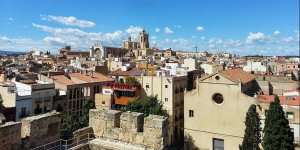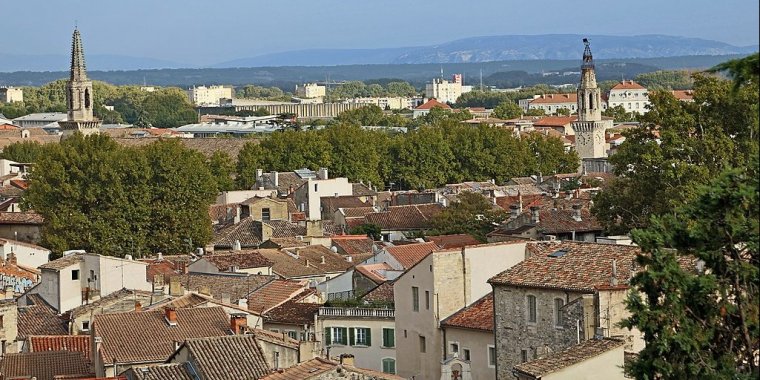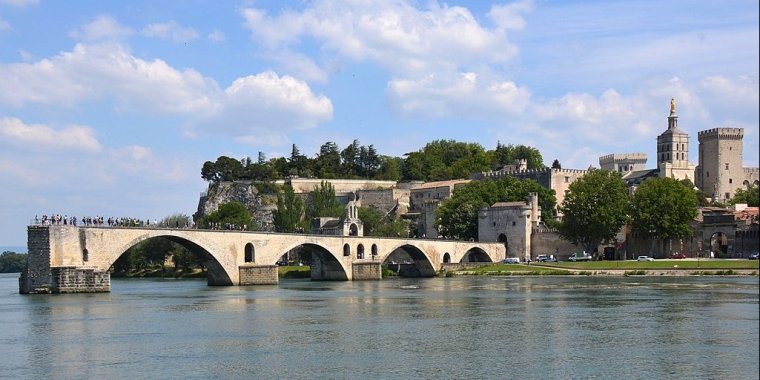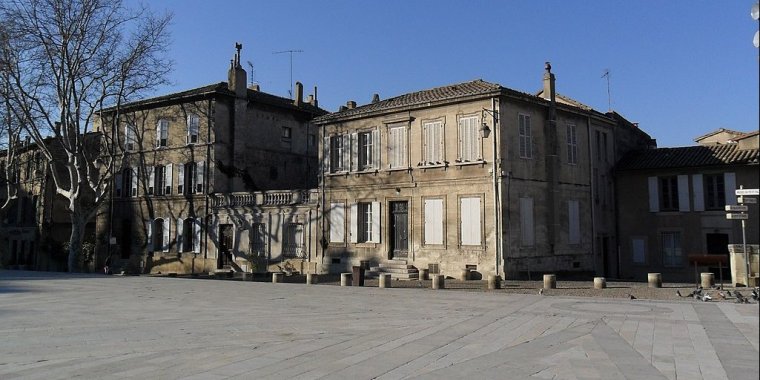| Published in Destinations |
Avignon, France
Avignon is famous as the city to which the Popes fled when leaving the corruption of Rome in the 14th century. Le Palais des Papes (Palace of Popes) which was built then is the world's largest Gothic building. It was largely emptied over the centuries, and its vast stone rooms are filled with little more than old frescos, but it is still an imposing building. The Ramparts themselves were erected to keep the plague and invaders out during the turbulent Middle Ages, when Avignon belonged to the papacy and not the French crown.
Get in
By plane
• Aéroport d'Avignon-Caumont (Avignon Airport AVN). Cityjet and Flybe operate flights from the United Kingdom.
By train
• Gare d'Avignon Centre (Avignon central station), Boulevard Saint-Roch. Local and regional trains call at the central station, just outside the walls on the southern edge of the old town.
• Gare d'Avignon TGV (Avignon TGV Station), Avenue de la Gare, 84000 Avignon (about 2 km out of town; a regular shuttle train to the Avignon central station). Avignon lies on the TGV line from Paris (2.5h) to Marseille. It is also served by numerous local and regional services. Eurostar operates several services a week from London St. Pancras International, with a journey time of around 6 hours.
By bus
Avignon is connected to most other European cities with Eurolines. For regional travelers, following your common source, you can take: the Vaucluse département cars circulating in the appelation "TransVaucluse Network"; departmental cars Bouches-du-Rhône, whose schedules are available on Lepilote; departmental cars du Gard, working under the name of "Edgar". All lines to the terminal bus station Avignon, itself located near the train station and the walls surrounding the city center.
By boat
While there is no regular boat line in Avignon, you can arrive by boat in Avignon via river cruises.
By car
From Paris or Lyon, you can reach Avignon by the Autoroute du Soleil and take the Avignon-Nord exit and follow the N107 then the D225 towards AVIGNON Centre. This urban road leads straight to the famous Avignon bridge just before where you have a large pay car park (car park the Palais des Papes), which leads directly onto the Place du Palais des Papes in the heart of the city.
Other parking solutions, the municipality has set up 2 ' relay ' parking + free shuttle " ' , with one bus every 10 minutes from 10:00 to 22:00. The first "Parking Italians" , accessible the D225 road which runs. Circuit the shuttle drops users directly in the intramural centre , near the Town Hall Square; the second is located on the Ile de la Barthelasse ( head Villeneuve lès Avignon and follow the signs). The shuttle drops users to Gate Oulle, about 200m from the bridge of Avignon (Saint Bénézet bridge).
From Montpellier or Nîmes, exit on the A9 (exit Roquemaure, the first after the junction with the A7), then follow the direction Avignon.
Get around
The old city centre is not very big and can be easily explored on foot. An automatic bike sharing scheme called Vélopop' allows you to ride along. Smartcard needed.
What to See in Avignon
• Papal Palace (Palais des Papes), Place du palais des papes. This is the palace where the Popes of Avignon ruled, during a period when the Papacy was divided, with a Pope in Rome and another in Avignon. Most of the artwork inside (statues, frescoes) was destroyed during the French Revolution, but the impressive building still stands, and little bits of artwork, such as those that were too high to be convenient to ruin, remain.
• Le Pont Saint-Bénezet (Le Pont d'Avignon). It is a ruined bridge not far from the Palais des Papes. The bridge was built in the Middle Ages — before the arrival of the Papacy — perhaps partly to allow the local bishop to cross the river to Villeneuve-lès-Avignon, where the church authorities had installed themselves because of Avignon's then-infamous dirt and lawlessness.
The legend of the bridge's building is that a local shepherd, Benezet (a dialect form of Benedict) was inspired by angels to build a bridge. When his appeals to the town authorities proved fruitless, he picked up a vast block of stone and hurled it into the river, to be the bridge's foundation stone. Convinced by this demonstration of divine will, the bridge was swiftly built. The poor shepherd boy was canonised, and his chapel remains on the surviving portion of the bridge.
If the bridge was divinely inspired, the Deity must have quickly changed his mind, because before long the bridge became unsafe and, following numerous floods, mostly derelict.
Originally, the bridge had 22 arches, reaching across to the tower of Philippe le Bel via the mid-stream île de la Barthelasse. Only 4 of the 22 arches now remain. A multilingual audio tour of the bridge explains some of the local history.
A well-known song Sur Le Pont D'Avignon (On the bridge at Avignon) refers to the bridge. The bridge itself is far too narrow for dancing or festivals - the original text of the song was "Sous (under) le pont d'Avignon", referring to the festivals and entertainments staged on the île de la Barthelasse. The current version was popularised by a 19th-century operetta, whose librettist clearly assumed that 'sous le pont d'Avignon' would have meant in the river.
• Notre Dame des Doms (12th century), the cathedral, is a Romanesque building, mainly built during the 12th century; the most prominent feature of the cathedral is the 19th century gilded statue of the Virgin which surmounts the western tower. The mausoleum of Pope John XXII is one of the most beautiful works within the cathedral, and is a noteworthy example of 14th-century Gothic carving.
• Minor churches of the town include, among others, three churches which were built in the Gothic architectural style:
— Church of Saint-Pierre (14th century) which has a graceful façade and richly carved doors
— Church of Saint-Didier (14th century)
— Church of Saint-Agricol (14th century).
• Civic buildings are represented most notably by:
— the Hôtel de Ville (city hall) (1846), a relatively modern building with a bell tower from the 14th century,
— the old Hôtel des Monnaies the papal mint which was built in 1610 and became a music-school.
• The Ramparts, built by the popes in the 14th century and still encircle Avignon. They are one of the finest examples of medieval fortification in existence. The walls are of great strength and are surmounted by machicolated battlements flanked at intervals by 39 massive towers and pierced by several gateways, three of which date from the 14th century. The walls were restored under the direction of Eugène Viollet-le-Duc.
• Other popular tourist destinations include: the Place du Palais, just next to the Place de L'horloge, though someone may find these places shockingly expensive, and overcrowded in season. Within a short distance in just about any direction are some smaller squares frequented by the locals, and much lower prices. Like Place Pie, with its covered market (open 6AM to 1PM everyday) which sells fresh produce, cheeses, wines, and produits du pays.
• Museums. Avignon has its share of museums, ranging from Modern Art Museums to museums housing artefacts from the Roman and pre-Roman days.
What to Do in Avignon
• Theatre Festival (Festival d'Avignon). Avignon is famous the world over for its annual theatre festival. For three or four weeks in July the city is virtually swollen with street performers, actors, musicians, and of course the ubiquitous tourists. The festival is an excuse to turn any room with enough seating into a 'salle de spectacle' and the city is host to a wide variety of entertainment. The gem of this festival are the performances which take place inside the Pope's Palace itself. Tickets are expensive, but this is considered by many French and European thespians to be a crowning achievement of their career. The vast majority of performances are, of course, in French but a number of foreign companies perform in other languages including English. Even without attending any events, the atmosphere and street theatre give the city a marvellous feeling.
• The International Congress Center. Was created in 1976 within the outstanding premises of the Palace of the Popes and hosts many events throughout the entire year.
• Avignon Fair, Chemin des Félons, mid-April. A modern-style fair. The wine competition of the Rhone Valley, organised upstream since 1980, gives its official results at this fair.
Buy
• Flea Market, Place des Carmes. Every Sunday morning. browse the tables looking for your hidden treasure.
• Food Market, Les Halles d'Avignon, place Pie. Every morning except Monday. Local specialties like olive oil, tapenade, local wines, cheeses, and pastries can be found at the market along with fresh local produce. Cooking classes are available on Saturday mornings.
• Pure Lavande, 61, rue grande Fusterie. This boutique specializes in lavender and lavender products.
Restaurants
• D'Ici et d'Ailleurs, 4, rue Galante. "fresh products on a sunny terrace."
• Fou de Fafa, 17 Rue Des Trois Faucons, e-mail: restaurantfoudefafa@gmail.com. dinner from 6.30pm. quality French food with an international twist.
• Restaurant l'Orangerie, 3 Place Jerusalem (A few minutes walk from the tourist-centre Place de l'Horloge). This is a small restaurant and the style is Provençal/Corsican. In Summer it has tables on the Square, the rest of the year it has four tables and bar on the ground floor and a few more upstairs.
• Terre de Saveurs, 1 Rue Saint-Michel (Just south of Places des Corps Saints). Mixed vegetarian and meat menu using fresh local ingredients to produce food highlighting Mediterranean flavours. Main dishes with meat, €14.50, without €13.50. Starters at €8.50 and desserts €6.50. Sit outside on the terrace, or inside in the dining room. They also sell locally made jams and tapenades.
• L'Epicerie, 10, Place Saint Pierre (tucked in a nice little square just south of the Palais des Papes). Try the Assiette Epicière for a plate full of provençal specialities such as tapenade, ratatouille, with a salad and some ham. Count around €25 for lunch, more with wine.
• Restaurant Christian Etienne, 10 Rue de Mons. A well known Provence chef, his restaurant is right next to the Palais des Papes. An excellent vegetarian menu is available.
Bars and Clubs
• Le Vin Devant Soi (wine shop), 4 rue Collège du Roure (just off of Rue de la République, south of the Place de l'Horlorge). Until 7PM or 8PM. This wine shop has a permanent tasting machine set up with 32 wines. You purchase tasting credit for however much you like, they give you a card that you can put in the tasting machine to select the wine you want to taste. Tastes come in three different sizes, with different prices for different wines. The staff is very friendly, and there is a nice atmosphere.
Hotels and Hostels
• Auberge-Camping Bagatelle, Île de la Barthelasse. This Hotel/ Hostel and Camp Site is situated on Ile de la Bathelasse in the centre of the Rhone . This is perhaps the best place to stay on a budget. It has great facilities and offers perhaps the best view of the center of Avignon. Carries a basic menu restaurant. Another benefit is that is placed directly between Avignon and the opposite town Villeneuve-les-Avignon, both begin within 10 minutes walk. €16.56 with complimentary breakfast.
• Hotel d'Angleterre, 29 Boulevard Raspail (10 minutes walk from bus and trains station). some rooms with bathroom. Small hotel located within the city walls. Has a small private car park. Its use is free of charge if you can find a place for your car. €40.
• Altera Roma Hotel, 13-15 Avenue Monclar (just behind the central station, which faces the main avenue of downtown and the bus station), e-mail: contact@alteraromahotel.com. Family run hotel overlooking a flowered garden, within a private carpark. Internet wi-fi available in the whole building. Recently renovated rooms with the typical Provencal style. 7 languages spoken. Private taxi service. Double room with ensuite shower and bathroom €30-60, studios and apartments from €75, breakfast €7 can be taken in the garden in season 7:30AM 11AM.
• Hotel Boquier Avignon, 6 rue du portail Boquier (in old city, near the tourism office). Check-in: 1PM, check-out: 11AM. A charming hotel in a XVIIIth-century house. 55-69.
• Hotel Danieli, Rue de la République. Very centrally with air conditioning and a good breakfast. €80 per night for a double during the summer, more expensive during the Festival d'Avignon.
• Mas du Clos de l'Escarrat Route de Carpentras chemin de l'Escarrat. €80 Bed & Breakfast.
• Hotel Le Colbert, 7 rue Agricol Perdiguier. Individual air conditioning room from € 78.
• Au Saint Roch, 9 rue Paul Mérindol, 84000 Avignon (South West from the middle age city), e-mail: contact@hotelstroch-avignon.com. Nice hotel with a very quiet garden. From €48 to €65, €7.50 for breakfast.
• Hotel d 'Europe, 12 Place Crillon, F84000 -Avignon. 5-star €350.
• 'La Mirande Hotel, 4 place de la Mirande, F- Avignon. 5 star hotel housed in a 700 year old converted townhouse €400 and up.
Tourist Info
• Office de Tourisme d'Avignon, 41, cours Jean Jaurès BP8, e-mail: officetourisme@avignon-tourisme.com. April to October: Monday to Saturday 9 am to 6 pm, Festival: everyday 9 am to 7 pm, Sundays and holidays 10am to 5pm; November to March: Monday to Friday 9 am to 6 pm, Saturday 9 am to 5 pm, Sunday 10 to 12. In the season there is also an information point at the TGV Station
• Henri Duffaut Hospital, 305 r Raoul Follereau,.
• Clinique Urbain V, chem Pont des Deux Eaux.
Go next
The surrounding region is full of interesting sites, There are three sites inscribed on the UNESCO World Heritage List
• Arles is full of Roman and Romanesque monuments and worthy of a full days exploration. 17mn from Avignon by TER.
• Orange just a short train ride to the north is home to one of the finest Roman Theatres in Europe.
• Le Pont du Gard is about 30 km to the West it is probably the finest Roman aqueduct still in existence, and a great place for hiking and canoeing.
• Nimes which has a huge Roman amphitheatre and a famous Greek Temple
• Châteauneuf-du-Pape is a short train ride north and is home to some of France's most famous vineyards
• Aix-en-Provence, town of water - town of art, founded by the Romans. (Wikivoyage, Wikipedia)
See also Avignon in Pictures.
YOU MAY ALSO LIKE






 If you own or manage a travel-related business such as a hotel, a bed-and-breakfast, a restaurant, a pub or a cafeteria, you can create a web page for your business for free on Titi Tudorancea Travel Info. » |







